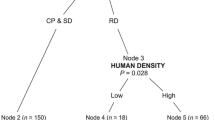Abstract
Aerially-foraging insectivorous bird populations have been declining for several decades in North America and habitat loss is hypothesized as a leading cause for the declines. Chimney Swifts (Chaetura pelagica) are a model species to test this hypothesis because nest site use and availability is easily assessed. To determine if nest site availability is a limiting factor for Chimney Swifts, we established a volunteer-based survey to inventory and describe chimneys (n = 928) that were used or unused by swifts. A logistic regression model showed that swifts preferred chimneys with a greater length exposed above the roofline and greater inside area, which were not associated with residential buildings. The average chimney used by swifts extended 2.86 m above the roofline with an internal area of 10,079 cm2. The regression model represents the range of nest-site conditions that swifts will tolerate; this was used to build a linear discriminant function (ldf) that had an I-index of 82 % (measure of prediction success). We applied the ldf coefficients to predict chimney occupancy in three southern Ontario communities. Of 366 open chimneys, the ldf classified 139 as suitable but only 24.4 % were occupied by swifts. Given that >75 % of suitable sites were unoccupied, swifts are likely not experiencing competition from habitat saturation. Our results suggest that Chimney Swift populations, and likely other aerially-foraging insectivorous birds, are limited primarily by other processes not measured in this study, such as changes in prey.


Similar content being viewed by others
References
Blodgett KD, Zammuto RM (1979) Chimney swift nest found in hollow tree. Wilson Bull 91:154
Böhning-Gaese K, Taper ML, Brown JH (1993) Are declines in North American insectivorous songbirds due to causes on the breeding range? Conserv Biol 7:76–86
Cink CL, Collins CT (2002) Chimney Swift (Chaetura pelagica). In: Poole A (ed) The birds of North America. Cornell Lab of Ornithology, Ithaca, p 646
Cornelius C, Cockle K, Politi N, Berkunsky I, Sandoval L, Ojeda V, Rivera L, Hunter M Jr, Martin K (2008) Cavity-nesting birds in neotropical forests: cavities as a potentially limiting resource. Ornitol Neotrop 19S:253–268
COSEWIC (2007) COSEWIC assessment and status report on the Chimney Swift Chaetura pelagica in Canada. Committee on the Status of Endangered Wildlife in Canada, Ottawa
Dickinson JL, Zuckerberg B, Bonter DN (2010) Citizen science as an ecological research tool: challenges and benefits. Annu Rev Ecol Evol Syst 41:149–172
Dickinson JL, Shirk J, Bonter D, Bonney R, Rhiannon Crain L, Martin J, Phillips T, Purcell K (2012) The current state of citizen science as a tool for ecological research and public engagement. Front Ecol Environ 10:291–297
Evans KL, Wilson JD, Bradbury RB (2007) Effects of crop type and aerial invertebrate abundance on foraging barn swallows Hirundo rustica. Agric Ecosyst Environ 122:267–273
Finity LK, Nocera JJ (2012) Vocal and visual conspecific cues influence the behavior of Chimney Swifts at provisioned habitat. Condor 114:323–328
Gibbons D, Gates S, Green RE, Fuller RJ, Fuller RM (1995) Buzzards Buteo buteo and Ravens Corvus corax in the uplands of Britain—limits to distribution and abundance. Ibis 137:S75–S84
Graham MH (2003) Confronting multicollinearity in ecological multiple regression. Ecology 84:2809–2815
Graves GR (2004) Avian commensals in Colonial America: when did Chaetura pelagica become the chimney swift? Arch Nat Hist 31:300–307
Grüebler MU, Korner-Nievergelt F, von Hirschheydt J (2010) The reproductive benefits of livestock farming in barn swallows Hirundo rustica: quality of nest site or foraging habitat? J Appl Ecol 47:1340–1347
Kyle P, Kyle G (2005) Chimney Swifts: America’s mysterious birds above the fireplace. Texas A&M University Press, College Station
Lawton JH (1993) Range, population abundance and conservation. Trends Ecol Evol 8:409–413
Nebel S, Mills A, McCracken JD, Taylor PD (2010) Declines of aerial insectivores in North America follow a geographic gradient. Avian Conserv Ecol. doi:10.5751/ACE-00391-050201
Nocera JJ, Blais JM, Beresford DV, Finity LK, Grooms C, Kimpe LE, Kyser K, Michelutti N, Reudink MW, Smol JP (2012) Historical pesticide applications coincided with an altered diet of aerially-foraging insectivorous chimney swifts. Proc R Soc B Biol Sci 279:3114–3120
R Development Core Team (2011) R: a language and environment for statistical computing. R Foundation for Statistical Computing, Vienna
Rioux S, Savard J-PL, Shaffer F (2010) Scientific and cost effective monitoring: the case of an aerial insectivore, the chimney swift. Avian Conserv Ecol. doi:10.5751/ACE-00425-050210
Ripley BD (1996) Pattern recognition and neural networks. Cambridge University Press, Cambridge
Salehi M, Brown JA (2010) Complete allocation sampling: an efficient and easily implemented adaptive sampling design. Popul Ecol 52:451–456
Wheeler H (2013) Foraging patterns of breeding chimney swifts (Chaetura pelagica) in relation to urban landscape features. MSc thesis, Trent University, Peterborough, Ontario
Acknowledgments
We are grateful for the dedication of Ontario SwiftWatch participants, whose efforts in collecting data for this project made this study possible. We particularly thank Winifred Wake, Nature London, Barrie SwiftWatch, Cambridge SwiftWatch, Guelph SwiftWatch (especially Mike Cadman), Halton SwiftWatch, Kingston Field Naturalists, Ottawa SwiftWatch, Pembroke SwiftWatch (especially Lauren Kruschenske), Stratford SwiftWatch, and two summer interns. We are also grateful for the coordination and promotion of Ontario SwiftWatch by Kathy Jones, Kristyn Richardson, and Doug Tozer. Financial assistance for this project was provided by the Government of Ontario and the Government of Canada.
Author information
Authors and Affiliations
Corresponding author
Rights and permissions
About this article
Cite this article
Fitzgerald, T.M., van Stam, E., Nocera, J.J. et al. Loss of nesting sites is not a primary factor limiting northern Chimney Swift populations. Popul Ecol 56, 507–512 (2014). https://doi.org/10.1007/s10144-014-0433-6
Received:
Accepted:
Published:
Issue Date:
DOI: https://doi.org/10.1007/s10144-014-0433-6




